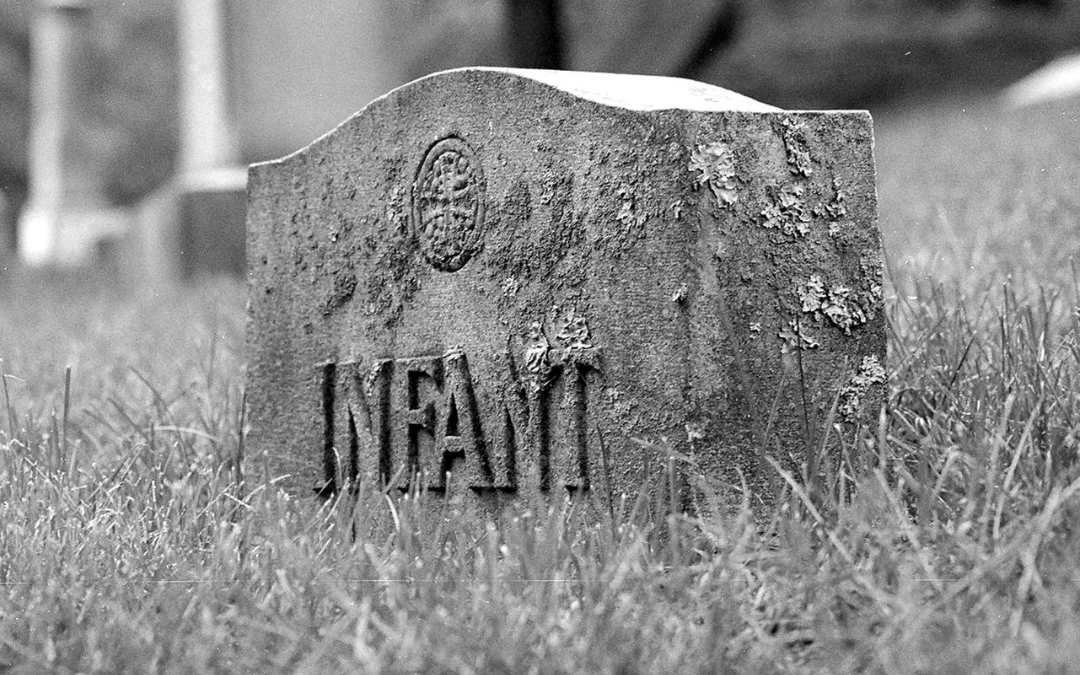While being bombarded with the pervasiveness of sudden adult deaths all throughout the globe, a term that I have been hearing for decades kept popping up in my head – sudden infant death syndrome (SIDS). I had believed that SIDS was a happening of chance or related to babies sleeping in the wrong position. Simultaneously, I discovered sudden death in the young (SDY), which was a new term to me. The information that I dug about the sudden deaths of our children is astonishing and terrifying!
Sudden Infant Death Syndrome
SIDS is “the sudden and unexpected death of an infant under 12 months of age that remains unexplained after a review of the clinical history and autopsy. Sudden infant death syndrome is part of the larger classification of sudden unexpected infant deaths (SUID). SUID is the sudden and unexpected death of an infant, including accidental deaths (suffocation or strangulation), sudden natural deaths (deaths from heart, vascular, metabolic, or neurological conditions), SIDS, and deaths due to unknown causes.
Risk Factors of SIDS
According to the CDC, the following are some of the risk factors associated with SIDS:
- Sleeping in the prone or side position: The medical community reports that these positions increase the risk of “re-breathing expired gases” which can lead to hypoxia or hypercapnia.
- Bedsharing: Sleeping with an infant is risky since sleeping adults can accidentally roll and suffocate him/her.
- Infectious diseases are mentioned since infections “can be subtle in infants and go unrecognized.”
- Other risk factors are little or no prenatal care, a mother younger than 20 years of age, prematurity or low birth weight, and parental alcohol consumption or smoking during pregnancy.
Rate of SIDS
SIDS is one of the leading causes of infant mortality in the US. Nearly 90 percent of SIDS cases occur between birth and six months of age with a peak incidence around two to four months.
Here are some CDC stats:
- 1960: the term SIDS didn’t exist but 17.6% of deaths were due to suffocation and 21% were due to “other causes.”
- 1973–79: SIDS was the leading cause of postneonatal death.
- 1988: 21% of infants died from SIDS, 8% due to respiratory distress, and 34.2% due to “other causes.” Between 1980 and 1988 were 47,932 SIDS deaths.
- 2015: 3,700 SUIDs – 1,600 were due to SIDS, 1,200 were due to unknown causes, and 900 were due to suffocation.
- 2020: 3,400 SUIDs – 1,389 deaths were due to SIDS, 1,062 deaths were due to unknown causes, and 905 deaths were due to suffocation.
- The SUID mortality rate varies widely from 39 to 161 per 100,000.
Epidemiology of SIDS
Upon further exploration, I run into A Fresh Look at the History of SIDS by James R. Wright, Jr., MD Ph.D. Here are some highlights from the history and non-publicized research on SIDS:
- Prior to organized vaccination programs, sudden infant death syndrome was extremely rare. It used to be referred to as “crib death” or “cot death” and wasn’t even mentioned in infant mortality statistics prior to the 1940s.
- 1947: Infants started to receive combination vaccines [smallpox and DPT (diphtheria, pertussis, tetanus)]. Researchers reported that 167 infants had died unexpectedly over a 15-year period. They noted that deaths rarely occurred in the first month or after the first year – the majority died in the first six months.
- 1953: of 299 SUIDs, 83% of the deaths couldn’t be explained.
- 1960s: National immunization campaigns became more prominent. Infants were required to receive more vaccines and doses [DPT (diphtheria, pertussis, tetanus), polio, measles, mumps, and rubella].
- 1969: SUIDs had become prevalent and the term SIDS was created.
- 1972: SIDS had become the leading cause of death in infants.
- 1979: All cause-of-death classifications associated with vaccination were eliminated from the International Classification of Diseases. A classification removed from the list was “prophylactic inoculation and vaccination.”
- 1992: The American Academy of Pediatrics wanted to reduce SIDS rates. Campaigns started, “Positioning and SIDS” later called “Back to Sleep,” recommended that all babies be put to sleep on their backs. Doctors wanted to reassure parents that SIDS deaths were not vaccine-related but from babies sleeping face down.
- 1992-2001: Post-neonatal rates associated with SIDS declined by an average annual rate of 8.6%. However, the rates of other classifications significantly increased, such as “suffocation in bed,” “suffocation other,” and “unknown and unspecified causes.”
- 1999-2015: U.S. SIDS rate declined by 35.8 % while infant deaths due to “suffocation” and “unknown and unspecified” increased by 183.8 %. The rates for “unknown and unspecified causes” and suffocation account for 90% of the decrease in SIDS rates.

Studies
- 1978–1979: 11 babies died within 8 days following DPT vaccination, and 5 of them died suddenly within 24 hr of vaccination. Health authorities said that a “causal relationship could be totally excluded.” Later on, the FDA said that experts didn’t find “a cause-effect relationship” and the CDC claimed that the SIDS cases that occurred shortly after DPT vaccination were a “coincidence.”
- 1980: Data analysis from the CDC revealed that 23 SIDS deaths occurred within 28 days following DPT vaccination, 52.2% within 24 hrs, and 78.3% within 7 days post-vaccination. Among these deaths, 70% were categorized as SIDS.
- 1982: William Torch, MD, director of Child Neurology, presented his research at the 34th Annual Meeting of the American Academy of Pediatrics. He reported that of 70 SIDS deaths, 75% died within 21 days following DPT vaccination – 6.5% died within 12 hrs of inoculation, 13% within 24 hrs, 26% within 3 days, 37% within 1 week, 61% within 2 weeks, and 70% within 3 weeks. He, also, found that unvaccinated babies who died from SIDS did so mostly during the fall or winter while vaccinated babies died mostly between their 2nd and 4th month of life. He concluded, “DPT may be a generally unrecognized major cause of sudden infant and early childhood death, and the risks of immunization may outweigh its potential benefits.”
- 1983: An analysis of 27 SIDS deaths showed that these infants had been vaccinated within 28 days, 17 deaths occurred during the first-week post-vaccination, and 6 within 24 hrs. “This study further substantiates the possible association between DTP immunization and SIDS.”
- 1986: A summary of cases from 12 countries showed that more than 200 deaths followed DPT vaccination. About 50% of these deaths occurred within 24 hrs, 75% within 3 days, and 90 % within 1-week post-vaccination. Some of these deaths were labeled as SIDS and others as death due to unknown causes.
- 1987: A study reported that there was a statistically significant increased risk of SIDS in the early days post-immunization. Babies had more than 7 times greater risk to die in the period 0–3 days following DPT vaccination than 30+ days post-vaccination.
- 1991: A presentation at the 2nd National Immunization Conference in Canberra, Australia showed an association between DPT injections and SIDS. A Cotwatch, a breathing monitor, was developed to measure babies’ breathing patterns before and after vaccination. The Cotwatch generated printouts of weighted apnea (cessation of breathing) and hypopnea (abnormally shallow breathing) density. The data showed that “pertussis vaccination caused an inordinate increase in episodes where breathing either nearly ceased or stopped completely” – the unhealthy breathing episodes continued for several weeks post-vaccination.
- 1990-2019: Of 2605 infant deaths in VAERS, 58% took place within 3 days post-vaccination and 78.3 % within 7 days. The remaining deaths occurred between 8 days and 60 days post-vaccination.
It seems that infant mortality rates have been obfuscated. It’s interesting to note that in the SUID classification, the CDC added a category, “deaths due to unknown causes.” Since those deaths are unknown and sudden, why not included them in the SIDS category? This is another way to show low SIDS rates.
Death certification practices have been changed, giving the impression that SIDS decreased over the years. Yet, the reality is that all cause-of-death classifications associated with vaccination were eliminated and SIDS cases were reclassified under other names starting in the early 1990s.
This is not surprising or the first time that death classifications are changed to fit a certain narrative. The same thing took place in 2020 but in the opposite direction. It has been proven that the CDC hyperinflated deaths classified as COVID to maintain the state of emergency and misappropriate trillions of dollars from public funds. The FDA has also been caught approving toxic pharma products, hiding damaging side effects, and lying for the companies that reward them very well financially.
Low SIDS rates keep attention away from infant deaths that take place suddenly and are “unexplained.” In turn, no public outrage or further investigations take place and the current immunization schedule remains unchallenged. However, it is hard to deny the connection between vaccines and SIDS.

Sudden Death in the Young
In the quest of researching children’s mortality rates, I discovered sudden death in the young (SDY). It seems that this term (SDY) started appearing in the medical literature in the past six years. SDY is the sudden and unexpected death of youngsters, those younger than 20 years of age. According to the CDC, there is no specific diagnosis in many SDY cases so it’s like SIDS but for older kids.
Death Rates Related to SDY
The following is an analysis of 1319 sudden unexpected deaths of infants (<365 days) and children (1-17 years) taking place between 2015 and 2016 in 9 states. Only 1132 deaths (889 infants, 243 children) were studied due to having complete reports:
- The SDY rate for infants was 120 per 100,000.
- 70% of infant deaths were unexplained (83 per 100,000).
- Among the explained infant SDY, 22% were due to suffocation (26 per 100 000), 69% respiratory (4.7 per 100,000), 3% possible cardiac (3.1 per 100,000), and 2% explained cardiac (2.7 per 100,000).
- The SDY rate for children was 1.9 per 100,000. SDY was least common in children ages 6 to 9 (1.1 per 100,000 children) and most common at age 1 (7 per 100,000 children) and between 14 and 17 years (2.4 per 100,000).
- 43% of child deaths were unexplained (0.8 per 100,000).
- Among the explained child SDY, 50% were respiratory, 16% explained cardiac, and 28% were possible cardiac/sudden unexpected death in epilepsy.
Conclusion
The USA is one of the richest, most advanced, industrialized, and medically competent nations in the world. Isn’t curious that we have an infant mortality rate higher than 49 countries? Our infant mortality rate is higher than that of Cuba, Guam, South Korea, Taiwan, Slovenia, Spain, Italy, Singapore, the UK, Australia, Lithuania, Ireland, Japan, Canada, and many more countries. We are, also, one of the countries with the highest number of childhood vaccines.
Research, which is hidden and never publicized, tells us that over 75% of SIDS deaths take place within 3 weeks of vaccination. Some of these infants die within 12 hrs of inoculation, others within 24 hrs, others within 3 days, 7 days, 14 days, and some within 21 days. How can we explain that and avoid drawing conclusions about a causal relationship between these two variables? Is it related to some of the toxic vaccine ingredients?
In addition, about 90 percent of SIDS deaths occur between birth and six months of age, peaking between months two and four. Do you realize that between months 2-4, infants receive at least 12 shots, and by month 6, they have received 19 shots? By age 1, infants have received at least 22 shots and at 1.5 years of age, they get a break from vaccination. Between ages 4 and 6, children get 6 shots, and again between ages 12 and 17, these youngsters get at least 5 shots. Is it a coincidence that infant deaths run parallel to the vaccination schedule?
Another point to consider is that if the leading cause of SIDS is that babies sleep on their side or face down and suffocate, wouldn’t we see more deaths in the first 2 months of life when infants are more fragile, have no upper body strength, and can’t move out of suffocating situations instead of in between their second and sixth months of life?
Looking at SDY data, we also know that most sudden deaths remain unexplained and occur in the sixth and twelfth months of life, and between ages 14 and 17. By looking at the Child and Adolescent Immunization Schedule, we can detect that sudden deaths intersect during these periods of vaccination too.
Is it a fortuitous occurrence that infants and children have a higher risk of dying during the months in which they have received shots? Is this as coincidental as the sudden adult deaths that we are witnessing around the world nowadays? Feel free to decide.
To a Fitter Healthier You,
The Fitness Wellness Mentor



